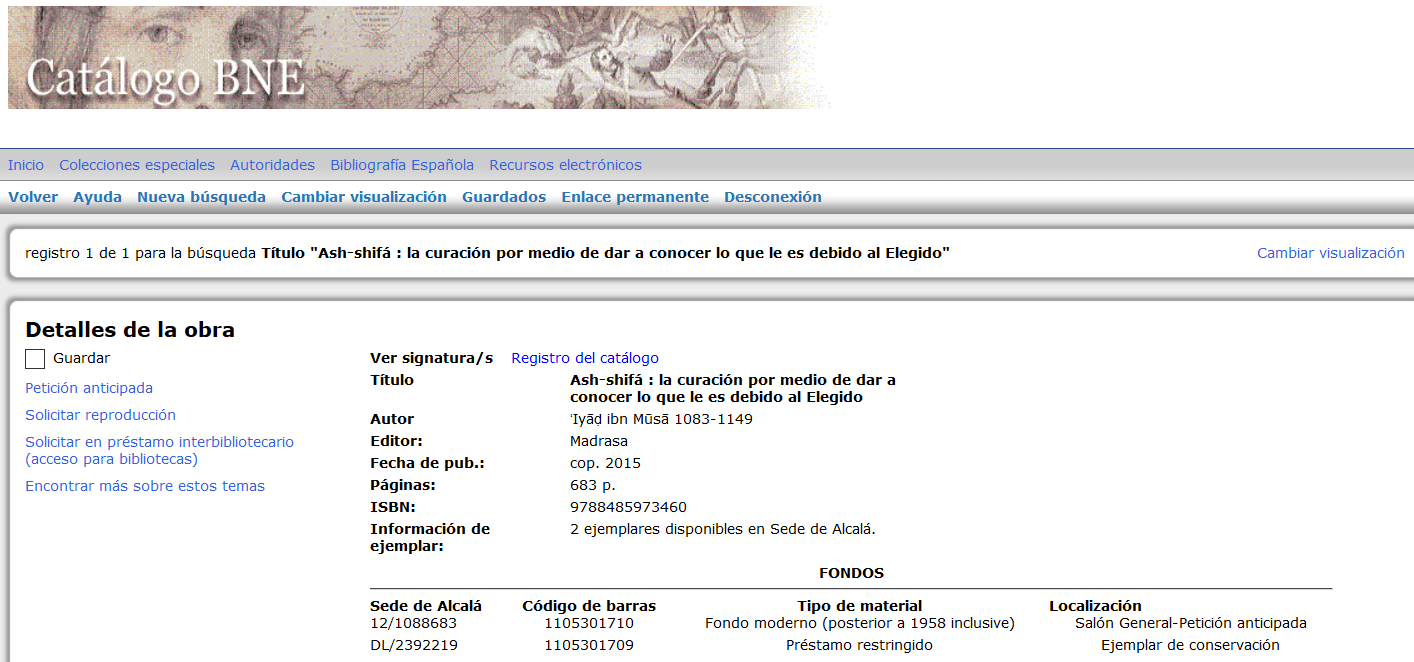Sampling problems often tell researchers about the topic they are studying.
Gaye Tuchman and Nina Fortin, Edging Women Out, 1989
All categories of evidence available to scholars are heavily dependent on patterns of recording and publication.
Christopher Howgego, Ancient History from Coins, 1995
For the next twenty-three months I will use this blog to report regularly on MASHQI (http://cordis.europa.eu/project/rcn/206308_en.html), the research project of my Marie Curie Fellowship at the Consejo Superior de Investigaciones Científicas (CSIC) in Madrid. At the Instituto de Lenguas y Culturas del Mediterráneo y Oriente Próximo (ILC) of the Centro de Ciencias Humanas y Sociales (CCHS) I will be working on the transmission and reception of the Kitāb al-shifāʾ bi-taʿrīf huqūq al-Muṣṭafā (“The book of healing concerning the recognition of the true facts about the chosen one”) by ʿIyāḍ b. Mūsā Abū’l-Faḍl al-Yaḥṣubī al-Sabtī (1083-1149), a highly regarded authority of Maliki Islam, also known as Qāḍī ʿIyāḍ. At the CSIC, the project is sponsored by Professor Maribel Fierro, and its origins are our shared interest in the Kitāb al-shifāʾ’s continuing popularity with Muslim readers in the early twenty-first century.
In Middle Eastern and Islamic studies there is a marked preference for works for which at most a few copies have been preserved. The situation reflects in part the pragmatism of a field with fewer scholars than fields such as history or English studies. We do know that there are still too many texts in Arabic, Persian, or Turkish, as well as in the languages of Muslim communities in Africa, Central Asia, China, and the Pacific Rim, which have not yet received any scholarly attention at all. While the discovery of new texts and unknown authors will make an obvious contribution to the human knowledge base, the focus on the not yet discovered is not without drawbacks. Familiar works and authors are deeply integrated into our research infrastructure, because they constitute the foundations of our knowledge of the history of Muslim societies. Consequently, the assumptions upon which this received disciplinary consensus rests is rarely questioned. On the one hand, it is difficult to be critical of that which is familiar. There is simply not enough distance to see the rough edges and contradictions that are so obvious from afar. On the other hand, time and funding are always limited. In order to complete research projects on a tight schedule, it is important to be careful about the battles we pick. Not every fight is worth having – whatever the whisperings of our heroic id.
Against this backdrop, my project tries to accomplish two goals. The first is to use the Kitāb al-shifāʾ as a test case for the practical challenges of how to study a work with an extraordinarily rich transmission history. Luckily, these practical challenges are not unique to the Kitāb al-shifāʾ, and I can draw on research in quantitative codicology, enumerative bibliography, and the digital humanities in order to design my own approach. The second goal is to explore the reception of the Kitāb al-shifāʾ outside the Islamic West and the strongholds of Maliki Islam. My working assumption is that the diachronic study of a work’s reception provides insights into changing interpretations of the Kitāb al-shifāʾ which, in turn, serve as indispensable safeguards against any facile explanation for the enduring popularity of a twelfth-century work of hadith scholarship in the early twenty-first century. In this context I will also explore questions about the Kitāb al-shifāʾ’s literary genre. How does the Kitāb al-shifāʾ fit into the system of learned Islamic literature in the early twelfth century? I am furthermore keen to consider the Kitāb al-shifāʾ within the larger context of comparative hagiography, as literature about the lives of exceptionally holy men and women can be found in most religious traditions.
The Marie Curie Fellowship will allow me to conduct this research at one of the most important centers for the study of Islam in Iberia and Africa. Having arrived at the CCHS on 31 January 2017, for the last month I was very much preoccupied with getting settled in a new environment. At the end of March, the project has to pass its first milestone: the cataloguing template of the Kitāb al-shifāʾ‘s online database. One of the methodological challenges of any quantitative, cliometric approach is how to account for the truism that each corpus is also the outcome of chance and serendipity, although their importance varies from case to case. At the same time, the complimentary risk of missing the forest for the trees is equally grave. Nonetheless, the definition of the fields of the cataloguing template must happen at the beginning of the project, as the online database will unite the circa two-hundred references to manuscript copies and printed versions of the Kitāb al-shifāʾ, which Maribel Fierro and I have collected independently for years. The template’s fields will determine how the database can be sorted, and thus their definitions will predetermine how this corpus can be examined and analyzed.
To illustrate these abstract considerations with a concrete example, in October 2015 Madrasa Editorial published in Granada the first Spanish translation of the Kitāb al-shifāʾ, which had been prepared by the prolific translator Abdelghani Melara Navío. Since I am focused on the Kitāb al-shifāʾ’s reception before 1900, the logical conclusion would be to exclude all printed versions, in whatever language, from the corpus published after 1900. Unfortunately, at this point it is difficult to assess the downside of excluding the continuing publication of new versions of the Kitāb al-shifāʾ in Arabic, as well as in new English and French translations since 1900. How important are these contemporary versions for a deeper understanding of the roles of the Kitāb al-shifāʾ in the spiritual and intellectual lives of earlier generations of Muslim readers?
The record of the first Spanish translation in the online catalogue of the Biblioteca Nacional de España (BNE) indicates that the library owns not just one, but two copies:

The visual teaser that accompanied Abdelghani Melara Navío’s announcement of his new translation, posted on 30 October 2015 on the blog Islam Hoy, stresses that Spanish reading Muslims have now access to the Kitāb al-shifāʾ in their own language:

One of three images that accompanies the listing of the Spanish translation on AMAZON’s Spanish website shows the book against the backdrop of the Alhambra, one of the important lieux de memoires of Islam on the Iberian Peninsula which is connected with the biography of Qāḍī ʿIyāḍ:

One of the images in the banner of the translation’s publisher Madrasa Editorial, which is located in Granada, indicates which exalted company Qāḍī ʿIyāḍ and his Kitāb al-shifāʾ are keeping:

NB – I would like to thank Javier Albarrán Iruela for bringing the Spanish translation to my attention.

This project has received funding from the European Union’s Horizon 2020 research and innovation programme under grant agreement No. 706611.








